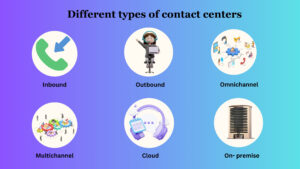Up to this point, we’ve examined the intricate details of call centers. Yet, these days, it’s significantly more typical for client cooperation with organizations to be finished through extra channels like informing applications, email, or web-based entertainment or informing stages (for example Facebook Messenger, WhatsApp, Apple Business Chat). On the off chance that you limit your contact choices to simply telephones, you could close out a part of your client base who favors different method for correspondence.
If you want to take advantage of all communication options to connect with your customers, you might want to consider a contact center instead.
What is a call center?
Generally, a call center is an office where various specialists give client support via phone.  Inbound call centers get calls for client care and frequently act as an information base for technical support, charging questions, and that’s just the beginning. These call centers around fast goal times and specialist efficiency. In outbound call centers, specialists settle on decisions as opposed to get them. These could be deals calls, advertising offers, overviews, raising support solicitations, or obligation assortment, for instance.
Inbound call centers get calls for client care and frequently act as an information base for technical support, charging questions, and that’s just the beginning. These call centers around fast goal times and specialist efficiency. In outbound call centers, specialists settle on decisions as opposed to get them. These could be deals calls, advertising offers, overviews, raising support solicitations, or obligation assortment, for instance.
For clients, the expression “call center” summons a picture of looking out for interminable hold or being steered through a perpetual intuitive voice reaction (IVR) framework that never gives them what they need. Since such countless buyers have had an encounter thusly, call centers have fostered unfavorable criticism. Yet, as inheritance telephone frameworks give approach to more up to date advanced innovations, call centers are developing.
What is a contact center?
A contact center is an incorporated office or division inside an association that handles different types of correspondence with customers and clients. Dissimilar to customary call centers, which essentially center around phone communications, contact centers use various channels, for example, calls, messages, live chat, web-based entertainment, SMS, and even video calls to draw in with clients.

The essential objective of a contact center is to give proficient and successful client care, deals help, specialized help, or different kinds of administrations. Contact centers often employ advanced technology such as customer relationship management (CRM) systems, automatic call distribution (ACD) systems, interactive voice response (IVR) systems, and workforce management tools to manage and streamline interactions.
Overall, contact centers expect to convey a consistent and reliable client experience across different correspondence channels, guaranteeing that clients get instant and customized help at whatever point they connect for help or data.
The difference between call centers and contact centers?
The essential distinction between call centers and contact centers lies in the extent of correspondence channels they handle and the idea of their communications with clients:
| Call Centers | Contact Centers | |
| Communication Channels | Call centers basically handle voice interchanges, zeroing in on inbound and outbound calls. They may likewise integrate intuitive voice response (IVR) systems for automated interactions. | Contact centers handle a more extensive scope of correspondence channels, including calls, messages, live talk, virtual entertainment, SMS/message informing, and some of the time video calls. They offer clients numerous choices to interface with specialists in view of their inclinations. |
| Functionality | Call centers are commonly centered around dealing with client requests, settling issues, or offering help through calls. They might have restricted abilities past voice connections. | Contact Centers offer greater flexibility in dealing with client communications by offering help across different channels. They often integrate customer relationship management (CRM) systems and different devices to oversee multi-channel communications flawlessly. |
| Customer Engagement | Call centers essentially draw in with clients through voice correspondence, which can at times restrict the profundity of connections and personalization. | Contact centers empower further commitment with clients by offering various touchpoints for correspondence. Specialists can offer more customized help and help in light of the channel through which clients decide to associate. |
| Service Offerings | Call centers ordinarily offer administrations, for example, client service, deals help, selling, and request handling, fundamentally through calls. | Contact centers grow administration contributions to incorporate client service, specialized help, deals support, outbound advertising, and then some, across different communication channels. |
5 benefits of a contact center
With a contact center, support specialists can interface with clients north of a few channels. This adaptability isn’t only advantageous for clients — it likewise implies there are more chances to find out about your crowd and practice customer care. The following are five key advantages your business can insight from utilizing a contact center.

6 types of contact centers
The following are six kinds of contact places, each having some expertise in various parts of customer service and communication:
Inbound Customer Service Centers: These focuses fundamentally handle approaching client requests, demands, and backing issues across different channels, for example, calls, messages, live visit, and social media.
Outbound Sales and Telemarketing Centers: Outbound contact centers work in settling on proactive decisions to clients for deals purposes, lead age, statistical surveying, or reviewing.
Technical Support Centers: Technical support contact centers furnish help with investigating, diagnosing, and settling specialized issues connected with items or administrations.

Multilingual Contact Centers: Multilingual contact centers take care of clients who communicate in various dialects or work in different worldwide business sectors.
Omni-channel Contact Centers: Omni-channel contact centers incorporate numerous correspondence channels flawlessly to give a bound together client experience.
Virtual Contact Centers: Virtual contact centers work from a distance, with specialists working from various areas instead of an incorporated office.
Conclusion
While both call centers and contact centers are fundamental for giving client care and correspondence administrations, they vary altogether in their extension, usefulness, and approach:
Call Centers:
- Essentially handle inbound and outbound calls.
- Center predominantly around voice correspondence.
- Offer administrations, for example, client care, deals help, and request handling.
- Restricted in correspondence channels contrasted with contact focuses.
- Frequently utilize interactive voice response (IVR) systems for computerized communications.
Contact Centers:
- Handle an extensive variety of correspondence channels, including calls, messages, live visit, web-based entertainment, SMS, and some of the time video calls.
- Give greater adaptability in client commitment and backing through numerous touchpoints.
- Offer administrations across different channels, including client care, specialized help, deals support, and outbound promoting.
- Use cutting edge innovation like customer relationship management (CRM) frameworks and labor force the board apparatuses to oversee multi-channel associations flawlessly.
- Empower further commitment with clients and more customized help in view of channel inclinations.
Ultimately, while call centers focus primarily on telephone-based interactions, contact focuses embrace a more extensive scope of correspondence channels to give far reaching and adaptable client care arrangements. The decision between a call place and a contact place relies upon the association’s correspondence needs, client inclinations, and business goals.


